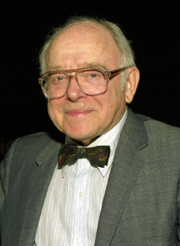
Clifford Shull, Neutron Diffraction, and Neutron ScatteringResources with Additional Information Clifford G. Shull was awarded the 1994 Nobel Prize in Physics "for the development of the neutron diffraction technique". ‘Professor Shull's prize was awarded for his pioneering work in neutron scattering, a technique that reveals where atoms are within a material like ricocheting bullets reveal where obstacles are in the dark.  Photo Courtesy of Oak Ridge National Laboratory When a beam of neutrons is directed at a given material, the neutrons bounce off, or are scattered by, atoms in the sample being investigated. The neutrons' directions change, depending on the location of the atoms they hit, and a diffraction pattern of the atoms' positions can then be obtained. Understanding where atoms are in a material and how they interact with one another is the key to understanding a material's properties. "Then we can think of how we can make better window glass, better semiconductors, better microphones. All of these things go back to understanding the basic science behind their operation," Professor Shull, then 79, said on the day of the Nobel announcement. ... He started [his pioneering work] in 1946 at what is now Oak Ridge National Laboratory. At that time, he said, "Scientists at Oak Ridge were very anxious to find real honest-to-goodness scientific uses for the information and technology that had been developed during the war at Oak Ridge and at other places associated with the wartime Manhattan Project." Professor Shull teamed up with the late Ernest Wollan, and for the next nine years they explored ways of using the neutrons produced by nuclear reactors to probe the atomic structure of materials. In Professor Shull's opinion the most important problem he worked on at the time dealt with determining the positions of hydrogen atoms in materials. "Hydrogen atoms are ubiquitous in all biological materials and in many other inorganic materials," he once said, "but you couldn't see them with other techniques. With neutrons it turned out that that was completely different, and we were very pleased and happy to find that we could learn things about hydrogen-containing structures." As he refined the scattering technique, Professor Shull studied the fundamental properties of the neutron itself. He also initiated the first neutron diffraction investigations of magnetic materials. ... "If there is a ... 'Father of Neutron Scattering' in the United States, it is Professor Shull," wrote Anthony Nunes ..., professor of physics at the University of Rhode Island. ... Professor Shull came to MIT as a full professor in 1955 and retired in 1986, though he continued to visit and to "look over the shoulders" of students doing experiments in the "remnants of my old research laboratory." ... Professor Shull's awards include the Buckley Prize, which he received from the American Physical Society in 1956, and election to the American Academy of Arts and Sciences (1956) and to the National Academy of Sciences (1975). In 1993 he received the Royal Swedish Academy of Sciences' Gregori Aminoff prize for his "development and application of neutron diffraction methods for studies of atomic and magnetic structures of solids."' – Edited excerpts from Clifford G. Shull, Co-winner
of 1994 Nobel Prize in Physics ...
Resources with Additional InformationAdditional information about Cliff Shull and his research is available in full text and on the Web. Documents:
Early Development of Neutron Scattering; Reviews of Modern Physics, Vol. 67, Issue 4, October 1995 -- Nobel Prize Lecture
Neutron Diffraction Analysis of NaH and NaD, DOE Technical Report, April 1947 The Diffraction of Neutrons by Crystalline Powders; DOE Technical Report; Physical Review, Vol. 73, Issue 8, 830–841; 1948 Neutron Diffraction Studies, DOE Technical Report, 1948 Laue Photography of Neutron Diffraction; Physical Review, Vol 73, Issue 5, 527-528, March 1, 1948 The Crystal Structure of Thorium and Zirconium Dihydrides by X-ray and Neutron Diffraction, DOE Technical Report, April 1951 Polarized Neutron Studies on Antiferromagnetic Single Crystals: Technical Report No. 4, DOE Technical Report, November 1958 Low Temperature and Neutron Physics Studies: Final Progress Report, March 1, 1986--May 31, 1987, DOE Technical Report, July 1989
Additional Web Pages:Oak Ridge Pays Tribute to its Nobel Prize Winner, Oak Ridge National Laboratory Shull Wins Physics Nobel for Work Done 40 Years Ago, MIT Development of Neutron Scattering Facilities, DOE Office of Science Properties of Neutrons, Spallation Neutron Source (SNS) The Clifford G. Shull Prize in Neutron Science, The Neutron Scattering Society of America |


 |
Information
Bridge • Energy
Citations Database • E-print
Network • R&D
Accomplishments
About OSTI Science.gov • USA.gov • USAJOBS • Grants • Regulations.gov |
|---|